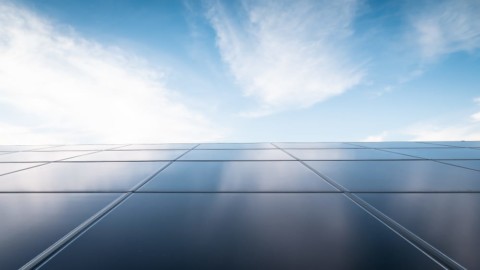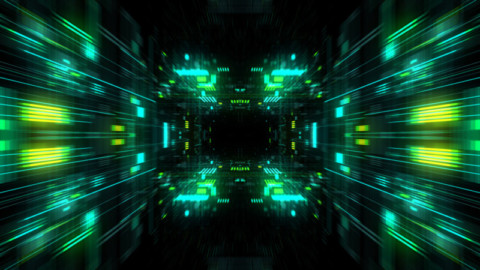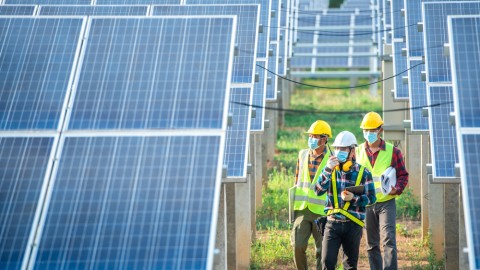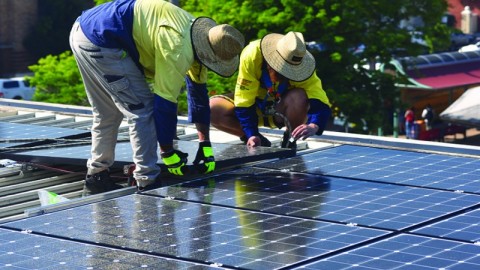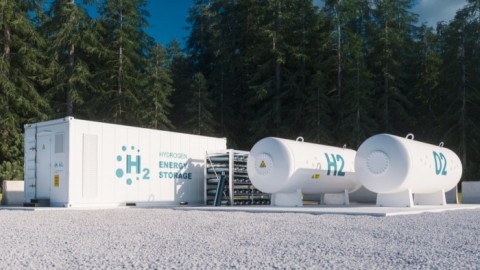Flanders, the Northern Region of Belgium, is commonly known for beer, chocolate and waffles. But did you know we are also at the forefront in innovation? From birth control pills, to COVID-19 vaccines, the modern atlas, tramways and plastics, they all found their origin in Flanders. Today, the innovation is continuing to address climate change, a burning issue – literally.
These innovations are no surprise, Flanders invests around 3.6 per cent of its GDP in R&D, in the top five in the world and is often ranked as one of the top innovating ecosystems in Europe, making Flanders state of the art.
Being one the most densely populated regions in Europe with almost no natural resources, efficiency is a necessity and climate change a challenge.
Flanders has committed to zero carbon emissions as part of the Paris Agreement, going from 74MTpa to 0 in 30 years. We are on an ambitious path towards slashing carbon emissions with several intermittent milestones. Across all sectors, from residential housing, offices, including government buildings, transport and of course industry, new solutions are being developed and implemented to reduce energy use, abate carbon and increase circularity.
Flanders is also the third most open economy in the world with four international sea ports that play an essential role in connecting Flanders, and the European hinterland, with the rest of the world, including Australia. Well connected to the European hinterland and in 500km radius, you will find 85 per cent of Europe’s consumer market. This makes Flanders a logistics power-hub for energy, food, chemicals and more.
We tackle these challenges through the power of international collaboration. Underlining the collaboration with Australia, Flanders already signed an Memorandum of Understanding (MoU) on green hydrogen and offshore energy with Tasmania in 2022, and we will be signing another MoU with New South Wales during the mission. Together we are working on finding new solutions in hydrogen and offshore energy and implementing them together.
Industrial decarbonisation and the energy transition is not an ambition in Flanders, we are doing it every day. Come and meet our experts to hear how and join the discussion.
Energy transition seminar at KPMG in Sydney on Monday 23 October – Registration
Flanders is using its collaborative quadruple helix of science, technology and innovation to reach zero carbon emission. Flanders, constrained on land and densely populated, looked offshore and focused on the blue economy to meet its clean energy needs. The existing 2.2GW of offshore wind will be extended with another almost 4GW of wind power (and more through floating offshore solar) by 2030. Moreover, next to domestic hydrogen production and use cases, Flanders is keen to maintain and reinforce its role as the energy import hub for Europe.
Industrial decarbonisation and energy transition are not just ambitions in Flanders, we are doing them every day. Come and meet our experts, Australian and international investors and government policy makers to learn more about projects pipeline and supply chain, and join one of our two break-out sessions which focus on new insights in industry decarbonisation, advancements in green hydrogen production and the role of ports in the energy transition, or offshore wind’s best practices from the first adopters in Europe – Flanders/Belgium and their application in Australia.
Following a general introduction by HE Jan Jambon, Minister-President of the Government of Flanders, the seminar includes the official signing of the Memorandum of Understanding on green hydrogen and offshore energy collaboration between the Government of Flanders and the New South Wales Government.
Program of the Offshore Wind break-out session
11:45 – 11:50: Introduction and welcome by Session Chair
11:50 – 12:00: Presentation – Offshore wind expertise in Flanders/Belgium – history and future (Blue Cluster)
12:00 – 12:10: Presentation – Offshore wind development in Australia – status and challenges (KPMG)
12:10 – 12:50: Panel discussion – The development of offshore wind in Australia, opportunities and pitfalls
12:50 – 12:55: Closing remarks by Session Chair
Speakers
- Session Chair: FIT – Kim Demeyer
- Blue Cluster: Piet Opstaele
- KPMG: Sally Torgoman
Moderator:
- KPMG – Sally Torgoman
Panelists:
- Deme Group
- Jan De Nul: Boudewijn van de Veire
- Iberdrola: Timothy Nelson
- Parkwind: Mathias Van Steenwinkel
- Sarens: Peter Libert
- Investment NSW: Alice Cahill
Program of the Green Hydrogen and Industrial Decarbonisation break-out session
11:45 – 11:50: Introduction and welcome by Session Chair
11:50 – 12:00: Presentation – New methods of hydrogen production using Renewable Energy (UNSW)
12:00 – 12:10: Presentation – The role of ports in industrial decarbonisation (North Sea Port)
12:10 – 12:50: Panel discussion – Green hydrogen and industrial decarbonisation
12:50 – 12:55: Closing remarks by Session Chair
Speakers
- Session Chair: FIT
- North Sea Port: Daan Schalck
- University of New South Wales: Xiaojing Hao
Moderator:
- WaterstofNet – Adwin Martens
Panelists:
- Engie: Niels Leemput
- Hiringa: Andrew Clennett
- NSW government: Tim Stock
- North Sea Port: Daan Schalck
- University of Hasselt: Bart Vermang
Please, register your participation on the event webpage or email [email protected].
An industrial powerhouse, on the way to decarbonisation
Next to WWI Flanders Fields, heavy industry and manufacturing have found a home in the Northern Region of Belgium. Essential for the economy and a driver for innovation, it is also a source of a high volume of hard to abate carbon emissions. Pursuing a net zero carbon region is a challenge that we tackle head on, with all stakeholders.
As one of the most open economies in the world – 1 in 20 goods transported worldwide passes through Flanders – free and efficient trade is essential for Flanders. The four ports in Flanders play a key role in the international trade and represent also the largest industrial clusters. Each with their own specialty, from project cargo, over the largest car terminal in the world to bulk and containers, they play an essential role in the European and world economy. Digital tools, like the platform of NxtPort International allows these trade flows to move efficiently, erasing waiting times and reducing the ecological footprint of shipping.
The port of Antwerp-Bruges (POAB) is home to the largest petrochemical cluster in Europe (the second in the world). Great amounts of energy, electricity and heat are used to fuel the processes that deliver the chemicals used in the products we use on a daily basis.
North Sea Port, one of the world’s only transnational ports, plays a pivotal role in trade with Australia. As a bulk specialist, they take care of the largest share of ores and grains that are imported into Europe. They are also a cluster with several carbon intensive sectors like steel making and vehicle manufacturing.
Within the objective of climate neutrality by 2050, the ports and the companies are taking steps to reduce their impact on the climate and the environment.
The BleuChem incubation center acts as an accelerator for sustainability chemistry in the Antwerp port area, while NextGen district will be a circular economy hotspot in the port, looking at all aspects, from materials to water and heat reuse. Residual heat from the port area is being shared between companies and with local communities in district heating.
Both ports are also investing in carbon capture capabilities. North Sea Port, with the steel plant of Arcelor Mittal has inaugurated a flagship carbon capture and utilization plant. They will use flue gasses of the steel plant to produce ethanol. With another project by Engie and Equinor, for a EU€1 billion hydrogen plant with CCS, the port is becoming the carbon trading hub of Europe.
Together with the gas grid operator, a CO2 network is being developed between the large industrial centers in order to provide CO2 as a feedstock to industry and to export CO2 to other countries or long term storage.
A green molecule production and import hub
Green molecules will be essential in the decarbonisation of industry. Flanders has a dual strategy of domestic production, as well as being the import hub for Europe.
Accelera, a subsidiary of Cummins, has their R&D center for PEM electrolysers in Flanders and is currently setting up a gigawatt scale plant in Flanders.
WaterstofNet, our hydrogen cluster, brings together over 170 companies, research institutes and universities to form a complete eco system including equipment manufacturers, system integrators and end users.
The BEHydro consortium has developed a dual fuel engine that can run on 100 per cent hydrogen, while several suppliers provide tanks for hydrogen storage (AMS) and hydrogen ready valves for the gas industry (Gas Flow Solutions).
Next to domestic hydrogen production and use cases, Flanders is keen to keep and reinforce its role as the energy import hub for Europe. Thanks to its central location, close connection with the industry areas in Germany, the Netherlands and France and extensive energy transport infrastructure, Flanders is a historic and important node in the European energy grid.
The LNG terminal in Zeebrugge (Flanders, Port of Antwerp Bruges), is one of the biggest in mainland Europe and has direct pipeline connections to large industrial sectors. The petrochemical sector in Antwerp (Flanders, Port of Antwerp-Bruges) is an import and production hub of specialty chemicals and is well connected to clients all over Europe through a dedicated pipeline network, among which a 600km privately owned hydrogen network, one of the largest in the world.
The gas grid operator in Belgium has already started construction on an open access hydrogen backbone that will plug into the European hydrogen backbone. This will be achieved through the construction of new pipelines, as well as the reconversion of existing natural gas infrastructure. The first 50km in Flanders is expected to be commissioned by the end of 2023. Future expansions will make connections
At the same time, the ports are working on import terminals for green molecules, in a first phase ammonia. The first ammonia import terminal is expected to come online by 2027.
The combination of terminal capacity and a well-connected gas grid enables both local and regional transport and use of these new gases, starting from Flanders.
A cleantech innovation hotspot
Flanders is the most densely populated region in Europe. This puts a limit on the amount of renewable energy that can be built.
However, the quadruple helix of science, technology and innovation has created a myriad of cutting edge start-ups and innovative solutions and have put a different perspective on the energy transition: an opportunity as well as a necessity.
VITO, the strategic research center for sustainability is working together with several other strategic research centers like IMEC (microelectronics) and spearhead clusters like the Blue Cluster (Blue Economy), Flux 50 (energy transition), SIM (new materials)… to push R&D breakthroughs towards commercial innovations.
Cleantech in Flanders employs over 30.000 people and generates over 100 patents per year in renewable energy alone.
Solar
Flanders has over 5GW of installed PV capacity, spread over more than 830,000 installations. Due to a lack of land, most of these are rooftop, existing out of both C&I rooftop, but also a very high number of home rooftop installations.
With 826W per capita, Flanders is in the top three of installed capacity per inhabitant in the EU. A large part of the population has embraced solar as a part of their home energy mix and an opportunity to reduce their energy bill.
Also industrial applications, from PV to Concentrated Solar Thermal, have a long history in the ecosystem. AZTEQ Solar is harvesting sustainable heat through a CST system providing high quality and sustainable heat up to 400°C, in a variety of use cases, from industry to district heating for communities.
But the innovation doesn’t stop there. Leveraging on its competences in microelectronics and sustainability, Energyville, the living lab of several university partners (a.o. the University of Hasselt and Leuven) and the world renowned IMEC research centre, houses the largest solar PV research group in Europe, covering all fields from research to the production of new types of solar cells and applications, as well as innovative batteries and energy storage systems. This will be part of the energy system of the future, requiring intelligent market management, included in the solutions of Gorilla.
The University of Leuven is also the birthplace of the SOLHYD panel, an innovative solar panel that produces hydrogen from the ambient air.
These innovations have created an integrated ecosystem that also covers hardware manufacturing and domestic PV panel production for customized PV system solutions (thin film, Building Integrated PV…).
Also keep an eye on the Innoptus solar team that will be participating in the 2023 world solar challenge from Darwin to Adelaide (22-29 October 2023) with the tenth Belgian solar car. In previous editions, they were always competing for first place, putting Flanders at the forefront of innovation!
During the mission the University of Hasselt and the University of New South Wales will reinforce their collaboration on PV and e-fuels by signing an MoU for collaborative research on this topic.
Wind
The high population density and limited land availability also put a limit to onshore wind development. Flanders currently counts 694 Wind Turbine Generators with a total installed capacity of 1.8GW.
With 272W per capita, Flanders is in the top 3 of installed capacity per inhabitant in the EU. There is an intimate link between wind energy and the industry in Flanders, as a lot of the onshore wind farms are located in industrial areas.
Did you know that almost every wind turbine in the world, onshore or offshore, has technology from Flanders inside? ZF wind in Lommel (Flanders) is the global research and test center for gearboxes for wind turbines of the ZF group. ZF is currently building a new test centre for wind turbine gearboxes of up to 30MW, making it future proof for the ever increasing size of wind turbines. This test centre comes on top of other test centres for the wind energy sector in Flanders like the Coastal and Ocean Basin and the Blue Accelerator in Oostende or the SIRRIS test center in Antwerp with the largest climate chamber in Europe.
Offshore wind; an essential part of a clean energy system
The constraints on land forced Flanders to look offshore to meet its clean energy needs. Despite the short coastline (66km) and small Exclusive Economic Zone (3,500sqkm), Flanders has eight offshore wind farms that came online between 2009 and 2020. With 399 turbines, there is 2.2GW of installed capacity in the first offshore wind zone, producing 7TWh of electricity, enough to power two million households.
The first offshore wind farm, C-Power, was one of the first offshore wind farms in the world, and ever since, companies from Flanders have been pioneering the offshore wind industry, covering the complete value chain.
Blue Cluster, the spearhead cluster for blue economy in Flanders, represents and coordinates research projects between over 180 companies and 19 research centers in the blue economy and ocean energy sector.
Parkwind, a subsidiary of JERA, has been developing, building and operating wind farms in Belgium and Europe since the very beginning, with a strong team headquartered in Leuven (Flanders), accompanied by experienced project management companies like Inframara.
Von Karman Institute of Fluid Dynamics is at the forefront of advanced CFD modeling for complex wind farms and was one of the first one in the world to perform a detailed study on the blockage effect between offshore wind farms.
Several companies like Enviros Group, are specialized in environmental and geotechnical studies, paramount for a high quality site assessment in a feasibility study.
An essential step in offshore wind development is the expansion of port capabilities. Offshore works also require a multitude of complex onshore operations to get the offshore equipment on board of the installation vessels. Sarens, a lifting specialist from Flanders has global experience in this type of operations.
DEME and Jan de Nul are specialists in marine and offshore contracting. From port construction over cable installation to offshore heavy lifting for foundations, transition pieces, wind turbines and even complete offshore substations. Together, they have been involved in the construction of over 80% of offshore wind farms worldwide.
Companies like Neanex, e-Bo and 24Sea provide communications equipment, control rooms and digital twins and AI solutions that help optimize offshore operations and maintenance management of the assets, while Zingametall and ACOTEC provide advanced corrosion protection solutions for offshore installations.
In order to decarbonise the whole value chain, Flanders is also moving towards hydrogen propelled vessels for wind farm operations. Hydrogen ready CTVs, developed in Flanders, are already faring and larger vessels like SOVs are being converted to be ready for hydrogen fueled operations.
The existing 2.2GW of offshore wind in Flanders will be extended with another almost 4 GW of additional wind power (and more through floating offshore solar) by 2030 in three additional offshore wind zones.
These new zones will also boast the world’s first offshore energy island. Next to its function as an aggregator for offshore generated power, it will provide an essential link for the European power grid, with connections to Denmark (Tritonlink) and the UK (Nautiluslink).
Blue Cluster and the Blue Economy CRC will sign an MoU to advance collaboration in marine spatial planning, offshore energy and aquaculture during the mission between Australia and Flanders.
This sponsored editorial was brought to you by Flanders-Energy. Register your participation on the event webpage or email [email protected].



